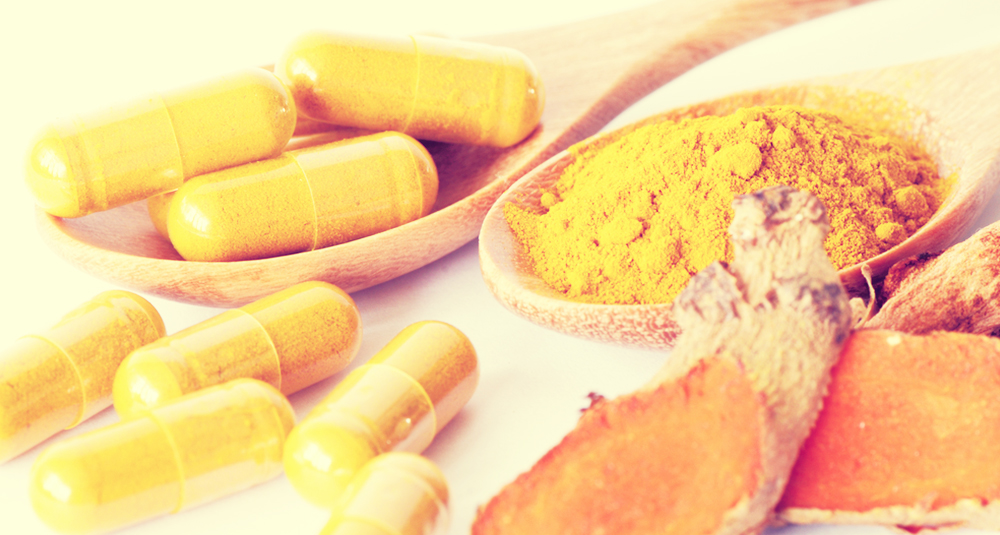Background
Turmeric (Curcuma longa) has a long history of use in traditional Indian (Ayurvedic) and Chinese medicine. For centuries, turmeric has been used to treat complaints such as gastrointestinal and liver disorders, poor digestion, anorexia, cough, diabetic complications, inflammatory conditions, traumatic injury with swelling and pain, rheumatism, sinusitis, menstrual problems, wounds, and skin diseases.[1,2]
Over the last 60 years almost 3000 preclinical investigations have shown curcumin – the principal active constituent of turmeric – is one of the most widely investigated botanical constituents in literature[3] and exerts antioxidant, antibacterial, antifungal, antiviral, anti-inflammatory, antiproliferative, pro-apoptotic and anti-atherosclerotic effects.[4]
Most of the recognised benefits of curcumin have been attributed to its powerful anti-inflammatory and antioxidant properties. Inflammation and oxidative damage have been shown to play a major role in many chronic and degenerative illnesses including neurodegenerative diseases, arthritis, allergy, inflammatory bowel disease, nephrotoxicity, AIDS, psoriasis, diabetes, multiple sclerosis, cardiovascular disease, lung fibrosis and neoplastic diseases.[4-6]
However, curcumin, in its natural state, is highly lipophilic and its poor bioavailability after oral administration has been a major therapeutic challenge. To overcome this, products with enhanced bioavailibility have allowed practitioners to access truly therapeutic curcumin.
Bioavailability of different curcumin formulations
While curcumin’s benefits are both wide and varied, its efficacy is not based on the amount of curcuminoids ingested, but rather how many curcuminoids are absorbed. The table below highlights the increased bioavailability of several commercially available formulas.

Key benefits
- Highly bioavailable form of curcumin
- Down-regulation of inflammatory mediators
- Inhibition of NF-kB activation
- Reduces joint inflammation
- Antioxidant support
- Cardiovascular support
- Reduces blood cholesterol
- Prevents LDL oxidation
- Inhibits platelet aggregation
- Anti-tumour effects
- Maintains healthy digestive function
- Support gallbladder contraction; helps emulsify fats in the digestive tract
- Support healthy liver function
- Reduces skin pigmentation
- Maintains skin moisture
- Enhances wound healing
- Inhibits HIV replication
Clinical applications
- Antioxidant support
- Any condition with a chronic inflammatory component including metabolic, neurologic and pulmonary
- Joint inflammation, arthritis
- Exercise-related muscular fatigue
- Cardiovascular disease
- Heart failure
- Cancer
- Dyspeptic complaints
- Inflammatory bowel disease
- Pancreatitis
- Liver support
- Alcohol intoxication
- Alzheimer’s disease
- Pulmonary fibrosis
- Type 2 diabetes
- Sun skin damage
Effect of curcumin on various proinflammatory diseases[6]

Mechanisms of action
Curcumin, the principal curcuminoid found in turmeric, is generally considered its most active constituent. Other curcuminoids found in turmeric include demethoxycurcumin and bisdemethoxycurcumin.[8]
Once absorbed, curcumin undergoes transformation in the intestines and liver and is metabolised to curcumin glucuronides, curcumin sulfates or hexahydrocurcumin. Plasma and serum measures of curcumin generally measure the sum of the curcumin and its metabolites.[8]
Anti-inflammatory
Studies have demonstrated that curcumin acts as a master switch of inflammation by acting at the level of pro-inflammatory enzymes and transcription factors, including nuclear factor-kappa beta (NF-kB), a critical mediator of inflammation.[5,9,10]
NF-kB is a ubiquitous inducible transcription factor involved in regulation of inflammation, immune function, and cellular proliferation and transformation.[4,10]
Curcumin is a pleiotropic molecule affecting numerous molecular targets involved in inflammation. Curcumin also modulates inflammatory responses by:[5,10]
- Inhibiting the production of inflammatory cytokines tumour necrosis factor-alpha (TNF-alpha), interleukin (IL) -1, -2, -6, -8, and -12, monocyte chemoattractant protein (MCP) and migration inhibitory protein.
- Down-regulating cyclooxygenase-2 (COX-2), lipoxygenase (LOX) and inducible nitric oxide synthase (iNOS) enzymes.
The pro-inflammatory cytokine TNF-alpha plays an important role in the regulation of immune cells and the development of systemic inflammation, and has been implicated in a variety of inflammatory diseases such as rheumatoid arthritis, Crohn’s disease, multiple sclerosis, psoriasis and cancer. Both in vitro and in vivo studies showed that curcumin has profound inhibitory effects on the production of TNF-alpha.[4]
This activity makes curcumin effective against a number of conditions related with chronic inflammation including cancer, heart failure, dementia, exercise-related muscular fatigue and arthritis.[9]

Neuroprotective
Curcumin is reported to possess anti-inflammatory, antioxidative, anti-amloidogenic and metal chelating properties that may result in neuroprotective effects.[11]1Alzheimer’s disease (AD) involves amyloid-beta accumulation, oxidative damage and inflammation. Curcumin can cross the blood-brain-barrier and bind to amyloid and related aggregates, therefore reducing plaque and fibril formation associated with AD.[12]
Cardioprotective
Inflammation plays a fundamental role in the pathogenesis of atherosclerosis and cardiovascular disease, and C-reactive protein (CRP) is routinely used as a reliable biomarker of systemic inflammation. Circulating CRP levels are associated with myocardial ischaemia and necrosis, and atherosclerosis. The curcuminoids in curcumin help to lower circulating levels of CRP.[13]
Curcumin’s protective effects on the cardiovascular system include lowering cholesterol and triglyceride levels, preventing low-density lipoprotein (LDL) oxidation, and inhibiting platelet aggregation and suppressing thrombosis.[1,14]
Antioxidant
Turmeric exerts significant antioxidant activity and curcumin has been shown to be the most potent component. In addition to a direct free radical scavenging action, turmeric also appears to enhance the antioxidant activity of endogenous antioxidants, such as glutathione peroxidase.[15]
Anticarcinogenic
Curcumin may affect the expression and activity of various proteins involved in cancer progression, particularly NF-kB. In cancerous tissues, upstream signals (growth factors, cytokines and hypoxemia) can activate NF-kB, which in turn upregulates the expression of downstream proteins involved in anti-apoptosis, cell proliferation, angiogenesis and metastasis; all of which can induce cancer progression.[9]
Curcumin has been found to induce cell-cycle arrest and apoptosis in a variety of cancer cell lines grown in culture. The mechanisms by which curcumin induces apoptosis may include inhibitory effects on several cell-signaling pathways.[8]
Cancerous cells invade normal tissue aided by enzymes called matrix metalloproteinases. Curcumin has been found to inhibit the activity of several matrix metalloproteinases. Curcumin has also been found to inhibit angiogenesis.[8]

Curcumin inhibits the activity of NFkB, a factor involved in cancer progression
Clinical studies
Enhanced absorption and bioavailability of Theracurmin
Background: The absorption efficacy of standard curcumin is often too low to exhibit significant clinical effects. The major reasons for the low bioavailability of curcumin are its poor water solubility and gastrointestinal absorption rates, rapid metabolism, and rapid systemic elimination. The bioavailability of a new absorption-enhanced curcumin formula, Theracurmin, is compared to that of ordinary curcumin powder.
Subjects/Method: Absorption rates were first investigated in rats, then in healthy human volunteers.
Intervention: Curcumin powder 30mg or Theracurmin (equivalent to 30mg curcumin). Theracurmin features a reduced particle size of curcumin suspended in a natural matrix, dramatically increasing its solubility and absorption.
Results: Theracurmin has at least 27 times higher bioavailability than ordinary curcumin powder in humans. These results indicate that Theracurmin may be useful to exert clinical benefits in humans at a lower dosage than ordinary curcumin.
Curcumin lowers C-reactive protein, a marker of inflammation
Background: Inflammation plays a pivotal role in the pathogenesis of atherosclerosis and cardiovascular disease (CVD). C-reactive protein (CRP), a biomarker of systemic inflammation, has been identified as a strong predictor and independent risk factor of CVD. Curcuminoids have been suggested to lower circulating levels of CRP.
Subjects/Method: Meta-analysis of six trials comprising 172 subjects in the curcuminoid groups and 170 subjects in the placebo groups.
Intervention: Various curcumin preparations (bioenhanced and standard).
Results: Compared with placebo, supplementation with curcuminoids was associated with a significant reduction in circulating CRP levels. This significant effect was maintained in subgroups of trials that used bioavailability-improved preparations of curcuminoids and had supplementation duration of four or more weeks, but not in the subgroups without these characteristics. Thus, this effect appears to depend on the bioavailability of curcuminoids preparations and also duration of supplementation.
Curcumin’s use in esophageal cancer
Background: In western countries the incidence of the esophageal adenocarcinoma (EAC) has risen at a more rapid rate than that of any other malignancy. Despite intensive therapies this cancer is associated with extreme high morbidity and mortality. The aim of this study was to investigate whether using a highly absorptive form of curcumin, dispersed with miniscule colloidal particles, named Theracurmin, would be more effective against EAC cells and to analyse if this new compound affects DC-induced T cell response. Curcumin is known for its anti-cancer effects.
Subjects/Method: OE19 and OE33 esophageal Barrett cancer cells.
Intervention: In vitro Theracurmin 50mcM concentration for 48 hours.
Results: Analysis found that Theracurmin is effective against
esophageal adenocarcinoma, sensitises esophageal adenocarcinoma cells to T cell induced cytotoxicity and decreases the pro-inflammatory signals from T cells. Combining dendritic-cell immunotherapy with Theracurmin is potentially a promising approach for future treatment of esophageal adenocarcinoma.
Cautions and indications
- Pregnancy and lactation: turmeric is likely to be safe when used as a spice, but the safety of therapeutic doses has not been established.[15]
- Curcumin lacks any major side effects.[9,18]
- Turmeric can cause gallbladder contractions and should not be used by individuals with gallstones or bile duct obstruction.[19]
- Turmeric has an antiplatelet effect and may cause excessive bleeding if used perioperatively. Advise patients to discontinue use at least two weeks before elective surgery.[19]
- Turmeric has an antiplatelet effect; avoid concomitant use with anticoagulant/antiplatelet drugs.[19]
- Animal studies suggest curcumin may reduce the efficacy of cyclophosphamide; avoid this combination.[15]
REFERENCES
- Sasaki H, Sunagawa Y, Takahashi K, et al. Innovative preparation of curcumin for improved oral bioavailability. Biol Pharm Bull 2011;34(5):660-665. [PDF]
- Bone K. A clinical guide to blending liquid herbs. St Louis: Churchill Livingstone, 2003.
- Belcaro G, Cesarone MR, Dugall M, et al. Efficacy and safety of Meriva®, a curcumin-phosphatidylcholine complex, during extended administration in osteoarthritis patients. Atern Med Rev 2010;15(4):337-344. [Abstract]
- Zhou H, Beevers CS, Huang S. The targets of curcumin. Curr Drug Targets 2011;12(3):332-347. [Full text]
- Basnet P, Skalko-Basnet N. Curcumin: an anti-inflammatory molecule from a curry spice on the path to cancer treatment. Molecules 2011;16:4567-4598. [PDF]
- Aggarwal BB, Harikumar KB. Potential therapeutic effects of curcumin, the anti-inflammatory agent against neurodegenerative, cardiovascular, pulmonary, metabolic, autoimmune and neoplastic diseases. Int J Biochem Cell Biol 2009;41(1):40-59. [Full text]
- Theravalues Corporation proprietary data 2013, Japan.
- Curcumin. Micronutrient Information Center, Linus Pauling Institute 2009, http://lpi.oregonstate.edu/infocenter/phytochemicals/curcumin/
- Shimatsu A, Kakeya H, Imaizumi A, et al. Clinical application of “curcumin”, a multi-functional substance. Anti-Aging Medicine 2012;9(1):43-51.
- Jurenka JS. Anti-inflammatory properties of curcumin, a major constituent of Curcuma longa: a review of preclinical and clinical research. Altern Med Rev 2009;14(2):141-153. [PDF]
- Chin D, Huebbe P, Pallauf K, et al. Neuroprotective properties of curcumin in Alzheimer’s disease - merits and limitations. Curr Med Chem 2013;20(32):3955-3985. [Abstract]
- Yang F, Lim GP, Begum AN, et al. Curcumin inhibits formation of amyloid beta oligomers and fibrils, binds plaques, and reduces amyloid in vivo. J Biol Chem 2005;280(7):5892-5901. [Full text]
- Sahebkar A. Are curcuminoids effective C-reative protein-lowering agents in clinical practice? Evidence from a meta-analysis. Phytother Res 2013. Wiley online library: 10.1002/ptr.5045. [Abstract]
- Curcuma longa (Turmeric) monograph. Altern Med Rev 2001;6(Suppl):S62-66. [Abstract]
- Braun L, Cohen M. Herbs & natural supplements, an evidence based guide, 3rd ed. Sydney: Churchill Livingstone Elsevier, 2010.
- Theracurmin. DoctorMurray.com, Your natural medicine resource 2013. Viewed 13 September 2013, http://doctormurray.com/theracurmin/
- Kanai M, Yoshihiko O, Kazunori O, et al. A phase I study investigating the safety and pharmacokinetics of highly bioavailable curcumin (Theracurmin) in cancer patients. Cancer Chemother Pharmacol 2013;69:54-70.
- Munjal B, Pawar YB, Patel SB. Comparative oral bioavailability advantage from curcumin formulations. Drug Deliv Transl Res 2011;1:322-331. [Abstract]
- Turmeric. Natural Medicines Comprehensive Database. Viewed 30 Aug 2013 http://www.naturaldatabase.com
DISCLAIMER:
The information provided on FX Medicine is for educational and informational purposes only. The information provided on this site is not, nor is it intended to be, a substitute for professional advice or care. Please seek the advice of a qualified health care professional in the event something you have read here raises questions or concerns regarding your health.


